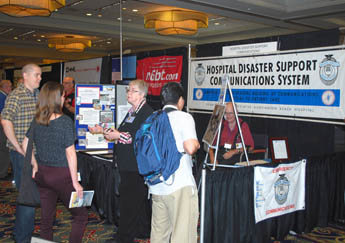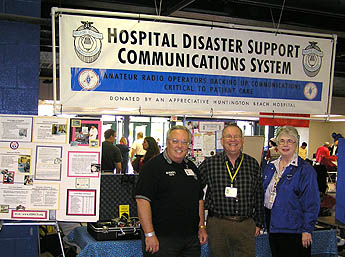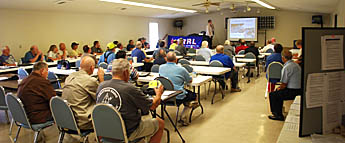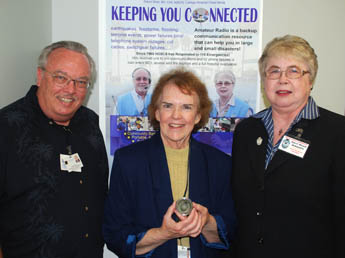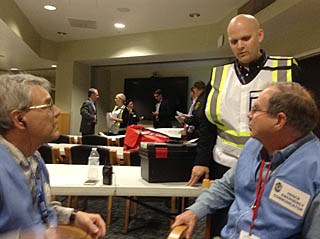
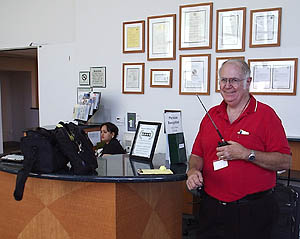

![]() Emergency Activation #124: HDSCS was activated by pager and telephone at 3:25 AM on March 17, 2017. All internal and external telephones were down at UCI Medical Center in Orange. Five HDSCS members responded with the first arriving at 4:30 and setting up his radio equipment in the Hospital Command Center, which had been activated in accordance with HICS procedures. Fortunately, telephones came up at about 5 AM, but the HCC remained open and HDSCS remained on site until 7 AM as functionality and reliability of the system was determined. Responding to the hospital were Bob Houghton AD6QF (on right in photo with hospital's Incident Commander), Greg Landers KE6DAN (on left in photo), Joe Moell KØOV, Claudia Whited W6YTD and Jim Whited AI6EZ. April Moell WA6OPS operated the external base station.
Emergency Activation #124: HDSCS was activated by pager and telephone at 3:25 AM on March 17, 2017. All internal and external telephones were down at UCI Medical Center in Orange. Five HDSCS members responded with the first arriving at 4:30 and setting up his radio equipment in the Hospital Command Center, which had been activated in accordance with HICS procedures. Fortunately, telephones came up at about 5 AM, but the HCC remained open and HDSCS remained on site until 7 AM as functionality and reliability of the system was determined. Responding to the hospital were Bob Houghton AD6QF (on right in photo with hospital's Incident Commander), Greg Landers KE6DAN (on left in photo), Joe Moell KØOV, Claudia Whited W6YTD and Jim Whited AI6EZ. April Moell WA6OPS operated the external base station.
![]() Emergency Activation #123: At 1:17 PM on December 12, 2016, HDSCS was called via cell phone by the Assistant Director of Security at Anaheim Global Medical Center. A complete failure had occurred in the hospital's telephone system and communications assistance, both internal and external, was needed. HDSCS activated four members who immediately set out for the hospital. First to arrive at about 2 PM was Bob Houghton AD6QF, followed by Paul Broden K6MHD, Dale Petes KI6ANS and Joe Moell KØOV. They set up in the Command Center, using the hospital's external antenna, and deployed to provide voice communications to critical units within the hospital. They also established an outside link via April Moell WA6OPS at a base station. Although some phones were up within an hour, the system was not fully functional, so the hospital continued to keep its Command Center activated and to follow Hospital Incident Command procedures. Shortly after 6 PM, Justin Ennen AI6CI arrived at the hospital as relief for one of the operators. HDSCS continued to provide backup communications where needed until the system was declared to be stable, an All Clear was declared, a debriefing took place and the Hospital Command Center was deactivated at 7:27 PM.
Emergency Activation #123: At 1:17 PM on December 12, 2016, HDSCS was called via cell phone by the Assistant Director of Security at Anaheim Global Medical Center. A complete failure had occurred in the hospital's telephone system and communications assistance, both internal and external, was needed. HDSCS activated four members who immediately set out for the hospital. First to arrive at about 2 PM was Bob Houghton AD6QF, followed by Paul Broden K6MHD, Dale Petes KI6ANS and Joe Moell KØOV. They set up in the Command Center, using the hospital's external antenna, and deployed to provide voice communications to critical units within the hospital. They also established an outside link via April Moell WA6OPS at a base station. Although some phones were up within an hour, the system was not fully functional, so the hospital continued to keep its Command Center activated and to follow Hospital Incident Command procedures. Shortly after 6 PM, Justin Ennen AI6CI arrived at the hospital as relief for one of the operators. HDSCS continued to provide backup communications where needed until the system was declared to be stable, an All Clear was declared, a debriefing took place and the Hospital Command Center was deactivated at 7:27 PM.
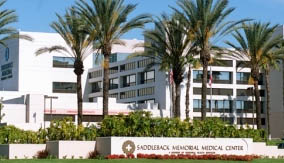
![]() At 1:13 PM on November 22, 2016, HDSCS Coordinators received an emergency 3-digit page from Saddleback Memorial Hospital in Laguna Hills. Attempts to call into the hospital were met with rapid busy signals indicating a likely problem with the telephone system. Using the HDSCS "First Wave" document, which identifies members that are most likely to be available for a particular hospital, two Coordinators began calling those who could activate to the hospital. Twenty minutes later, as our first responders were heading out and others were preparing, the HDSCS coordinator received word from the hospital's Assistant Disaster Coordinator that the phone system was up and functioning. She did not yet know why the main trunk lines had failed and was concerned about additional problems. It was decided she and HDSCS would stay in touch over the next hour to verify all internal and external lines were functional. Our lead radio operators stayed in "jump team" status, monitoring our frequencies and ready for immediate activation should that be needed.
At 1:13 PM on November 22, 2016, HDSCS Coordinators received an emergency 3-digit page from Saddleback Memorial Hospital in Laguna Hills. Attempts to call into the hospital were met with rapid busy signals indicating a likely problem with the telephone system. Using the HDSCS "First Wave" document, which identifies members that are most likely to be available for a particular hospital, two Coordinators began calling those who could activate to the hospital. Twenty minutes later, as our first responders were heading out and others were preparing, the HDSCS coordinator received word from the hospital's Assistant Disaster Coordinator that the phone system was up and functioning. She did not yet know why the main trunk lines had failed and was concerned about additional problems. It was decided she and HDSCS would stay in touch over the next hour to verify all internal and external lines were functional. Our lead radio operators stayed in "jump team" status, monitoring our frequencies and ready for immediate activation should that be needed.
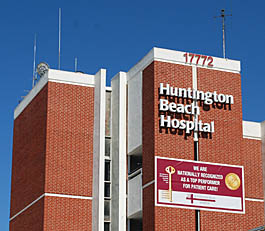
![]() On Thursday, October 1, 2015, a power outage darkened the homes and business of over 22,000 Southern California Edison customers in Huntington Beach and Fountain Valley. As soon as HDSCS coordinators became aware of the outage, they made calls to hospitals in the areas affected to determine if any phone problems existed. Both Fountain Valley Hospitals had no problems, but calls to three different numbers at Huntington Beach Hospital produced rapid busy signals. Following our established protocol, members were activated to this facility to check for a phone outage. As the first in operator drove into the hospital property, the phone system began to come back on line. Two other HDSCS operators were called off but continues to monitor the on-air net. Joe Orrico WB6HRO, the first-in operator, made contact with hospital staff and then stayed on site for 30 minutes to make sure the system functioned under load.
On Thursday, October 1, 2015, a power outage darkened the homes and business of over 22,000 Southern California Edison customers in Huntington Beach and Fountain Valley. As soon as HDSCS coordinators became aware of the outage, they made calls to hospitals in the areas affected to determine if any phone problems existed. Both Fountain Valley Hospitals had no problems, but calls to three different numbers at Huntington Beach Hospital produced rapid busy signals. Following our established protocol, members were activated to this facility to check for a phone outage. As the first in operator drove into the hospital property, the phone system began to come back on line. Two other HDSCS operators were called off but continues to monitor the on-air net. Joe Orrico WB6HRO, the first-in operator, made contact with hospital staff and then stayed on site for 30 minutes to make sure the system functioned under load.
![]() At approximately 8:15 AM on February 3, 2015, HDSCS member Cheryl Simpson KD6MWZ received a page from Western Medical Center in Santa Ana. Upon checking, she learned that a power failure that had caused the hospital to switch to its emergency generators. Cheryl and her husband Ken Simpson W6KOS alerted HDSCS Coordinator April Moell WA6OPS and Ken prepared to depart for the hospital. April made contact with the hospital's Communications Supervisor, who requested that two communicators come to the hospital to stand by in case of communications problems during the power outage. She contacted Tom Hall N6DGK, who began his response with Ken Simpson. A few minutes later, commercial power was restored. After consultation with the hospital's Incident Commander, the HDSCS operators' response was cancelled.
At approximately 8:15 AM on February 3, 2015, HDSCS member Cheryl Simpson KD6MWZ received a page from Western Medical Center in Santa Ana. Upon checking, she learned that a power failure that had caused the hospital to switch to its emergency generators. Cheryl and her husband Ken Simpson W6KOS alerted HDSCS Coordinator April Moell WA6OPS and Ken prepared to depart for the hospital. April made contact with the hospital's Communications Supervisor, who requested that two communicators come to the hospital to stand by in case of communications problems during the power outage. She contacted Tom Hall N6DGK, who began his response with Ken Simpson. A few minutes later, commercial power was restored. After consultation with the hospital's Incident Commander, the HDSCS operators' response was cancelled.
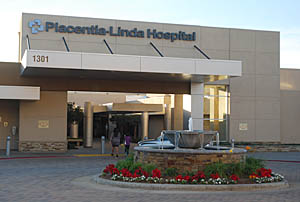
![]() Emergency Activation #122: At 6:45 PM on October 7, 2014, April Moell received a telephone call from the Disaster Coordinator of Western Medical Center in Santa Ana. There were no communications problems there, but he had just learned via ReddiNet* that all telephones were down at Coastal Communities Hospital nearby in Santa Ana. April immediately established an on-air net and alerted four HDSCS members in the vicinity of Coastal Communities Hospital to make a rapid response there. The first arrived at 7:30 PM and the others arrived very shortly thereafter. By then, the hospital's technician had replaced a power supply and phones were coming back up. By request of the Coastal Disaster Coordinator, the HDSCS operators deployed to the Hospital Command Center, Cardiac Care, Emergency Department and PBX/Security. They maintained an internal net until 9 PM to insure that the system was stable. Four additional members were standing by for relief in case the activation had lasted late into the night. Responding to the hospital were Ken Simpson W6KOS, Dave Popko AF6TN, Justin Ennen AI6CI and Tom Gaccione WB2LRH. Net Controls and supporting base stations were Allen Bullock KD6LCL, April Moell WA6OPS and Dave West KI6EPI.
Emergency Activation #122: At 6:45 PM on October 7, 2014, April Moell received a telephone call from the Disaster Coordinator of Western Medical Center in Santa Ana. There were no communications problems there, but he had just learned via ReddiNet* that all telephones were down at Coastal Communities Hospital nearby in Santa Ana. April immediately established an on-air net and alerted four HDSCS members in the vicinity of Coastal Communities Hospital to make a rapid response there. The first arrived at 7:30 PM and the others arrived very shortly thereafter. By then, the hospital's technician had replaced a power supply and phones were coming back up. By request of the Coastal Disaster Coordinator, the HDSCS operators deployed to the Hospital Command Center, Cardiac Care, Emergency Department and PBX/Security. They maintained an internal net until 9 PM to insure that the system was stable. Four additional members were standing by for relief in case the activation had lasted late into the night. Responding to the hospital were Ken Simpson W6KOS, Dave Popko AF6TN, Justin Ennen AI6CI and Tom Gaccione WB2LRH. Net Controls and supporting base stations were Allen Bullock KD6LCL, April Moell WA6OPS and Dave West KI6EPI.
![]() Emergency Activation #121: At approximately 6:30 AM on September 8, 2014, April Moell WA6OPS received a call via cell phone from Placentia-Linda hospital, where the telephone system had just gone down. The hospital was following established procedures by notifying HDSCS per its call-up list. April immediately established a network on the HDSCS main repeater and called members who lived nearest the hospital for rapid response to provide backup communications. As members set out for the hospital, the hospital's phones were brought back online, but Joe Moell KØOV continued to the hospital and remained on the HDSCS on-air net for a half-hour to be on-site in case the problem recurred.
Emergency Activation #121: At approximately 6:30 AM on September 8, 2014, April Moell WA6OPS received a call via cell phone from Placentia-Linda hospital, where the telephone system had just gone down. The hospital was following established procedures by notifying HDSCS per its call-up list. April immediately established a network on the HDSCS main repeater and called members who lived nearest the hospital for rapid response to provide backup communications. As members set out for the hospital, the hospital's phones were brought back online, but Joe Moell KØOV continued to the hospital and remained on the HDSCS on-air net for a half-hour to be on-site in case the problem recurred.
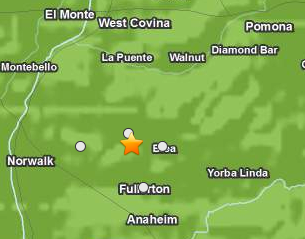
![]() Shortly after 4:30 PM on Thursday, July 24, 2014 an equipment fire at a Southern California Edison facility in Irvine caused a power outage that affected almost 8000 residential customers and two HDSCS-supported hospitals. Hoag-Irvine Hospital and Kaiser Permanente Hospital in that city immediately went on their emergency generators, which powered most but not all of these campuses. Upon learning of the outage, HDSCS went on alert status and formed jump teams that were ready to go on-site if telephone failures occurred at these facilities during the outage. HDSCS coordinators made contact with the Disaster Coordinator at Kaiser and the Telecommunications Lead at Hoag to review activation procedures and to keep in contact about the outage status. Fortunately, no telephone problems occurred during the outage, which lasted until 7:45 PM at Hoag and 8:45 PM at Kaiser. Members of the jump teams included Paul Broden K6MHD, Mark Kern KE6QXF, Dave Popko AF6TN, Bill Preston KZ3G, Ken Simpson W6KOS and Fred Wagner KQ6Q.
Shortly after 4:30 PM on Thursday, July 24, 2014 an equipment fire at a Southern California Edison facility in Irvine caused a power outage that affected almost 8000 residential customers and two HDSCS-supported hospitals. Hoag-Irvine Hospital and Kaiser Permanente Hospital in that city immediately went on their emergency generators, which powered most but not all of these campuses. Upon learning of the outage, HDSCS went on alert status and formed jump teams that were ready to go on-site if telephone failures occurred at these facilities during the outage. HDSCS coordinators made contact with the Disaster Coordinator at Kaiser and the Telecommunications Lead at Hoag to review activation procedures and to keep in contact about the outage status. Fortunately, no telephone problems occurred during the outage, which lasted until 7:45 PM at Hoag and 8:45 PM at Kaiser. Members of the jump teams included Paul Broden K6MHD, Mark Kern KE6QXF, Dave Popko AF6TN, Bill Preston KZ3G, Ken Simpson W6KOS and Fred Wagner KQ6Q.
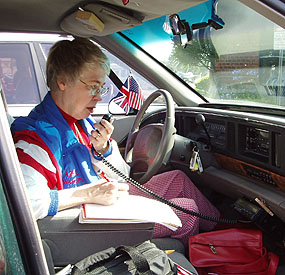
![]() HDSCS members were forming a net within seconds after the Richter 5.1 earthquake that struck north Orange County at 9:09 PM on March 28, 2014. Thirty members checked in during the first few minutes, ready for deployment to hospitals if needed. Twenty hospitals in the quake area were checked by HDSCS members, but fortunately none suffered significant damage or communications failure. The net was secured at 10:30 PM, but members continued to monitor for the remainder of the evening in case of strong aftershocks.
HDSCS members were forming a net within seconds after the Richter 5.1 earthquake that struck north Orange County at 9:09 PM on March 28, 2014. Thirty members checked in during the first few minutes, ready for deployment to hospitals if needed. Twenty hospitals in the quake area were checked by HDSCS members, but fortunately none suffered significant damage or communications failure. The net was secured at 10:30 PM, but members continued to monitor for the remainder of the evening in case of strong aftershocks.
* ReddiNet® is a commercial inter-hospital communications system using local Internet and satellite connections that is sold to hospitals by Healthcare Association of Southern California and maintained by the Communications Department of the County of Orange.
Back to the HDSCS home page
This page updated 14 October 2018
![]() Emergency Activation #120: An electrical failure took down all telephones at Placentia-Linda Hospital on Saturday evening, December 28, 2013. The hospital switchboard operator used the facility's Call-up List to notify HDSCS of the problem and request communications backup. HDSCS member Dale Petes KI6ANS was first to be reached at 8:25 PM. Dale followed HDSCS procedures by first calling a Coordinator (April Moell WA6OPS) and then setting out for the hospital with his go-kit. By 8:56 PM, Dale was operational in the Hospital's Command Center using his radio equipment and the hospital's rooftop antenna. As he was en route, three other HDSCS members, who were monitoring the main repeater, grabbed their go-kits and went to the hospital. By 9:20 PM, HDSCS operators were providing communications from the Command Center, Emergency Department, Intensive Care Unit and switchboard. Fortunately, the telephone problem was repaired and the phones returned to operation around 10:05 PM. After a 30-minute wait to insure that everything was stable, our operations were secured. In addition to Dale, the responders to the hospital were Pete Martinez K2PTM, Dahna Malheim KK6FIH and Dave Reinhard KJ6REP. Net Control and Base Station was April Moell WA6OPS. Ready in case an all-night response was needed were relief operators Paul Broden K6MHD, Dave Conklin KI6LYZ, Louie DeArman K6SM, Tom Gaccione WB2LRH and Ken Simpson W6KOS.
Emergency Activation #120: An electrical failure took down all telephones at Placentia-Linda Hospital on Saturday evening, December 28, 2013. The hospital switchboard operator used the facility's Call-up List to notify HDSCS of the problem and request communications backup. HDSCS member Dale Petes KI6ANS was first to be reached at 8:25 PM. Dale followed HDSCS procedures by first calling a Coordinator (April Moell WA6OPS) and then setting out for the hospital with his go-kit. By 8:56 PM, Dale was operational in the Hospital's Command Center using his radio equipment and the hospital's rooftop antenna. As he was en route, three other HDSCS members, who were monitoring the main repeater, grabbed their go-kits and went to the hospital. By 9:20 PM, HDSCS operators were providing communications from the Command Center, Emergency Department, Intensive Care Unit and switchboard. Fortunately, the telephone problem was repaired and the phones returned to operation around 10:05 PM. After a 30-minute wait to insure that everything was stable, our operations were secured. In addition to Dale, the responders to the hospital were Pete Martinez K2PTM, Dahna Malheim KK6FIH and Dave Reinhard KJ6REP. Net Control and Base Station was April Moell WA6OPS. Ready in case an all-night response was needed were relief operators Paul Broden K6MHD, Dave Conklin KI6LYZ, Louie DeArman K6SM, Tom Gaccione WB2LRH and Ken Simpson W6KOS.
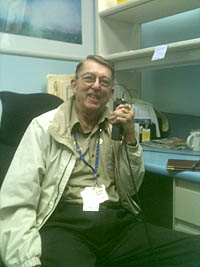
![]() Emergency Activation #119: At 8:30 PM on Monday, November 18, 2013, HDSCS was notified by Orange County Emergency Medical Service Agency of a telephone failure at Anaheim Regional Hospital. No incoming calls were being received and there was concern about other aspects of the system. Paul Broden K6MHD (pictured at left), who was monitoring the main HDSCS repeater, was prepared with his go-kit and immediately set out for the hospital. Besides serving as the outside base contact for the hospital, April Moell WA6OPS telephoned the Control One Supervisor at the county EOC and gave her number for contact in the event that the hospital needed to be reached by families, physicians, ambulance companies and other agencies during the outage. K6MHD remained on the air at the hospital until 11:45 PM when repairs were complete and the phone system was stable. If the outage had lasted further into the night or if the internal phones had also failed, a "jump team" of additional HDSCS members was standing by and monitoring the on-air activities. In that team were Dave Conklin KI6LYZ, Justin Miller KI6AFZ and Dave Popko AF6TN.
Emergency Activation #119: At 8:30 PM on Monday, November 18, 2013, HDSCS was notified by Orange County Emergency Medical Service Agency of a telephone failure at Anaheim Regional Hospital. No incoming calls were being received and there was concern about other aspects of the system. Paul Broden K6MHD (pictured at left), who was monitoring the main HDSCS repeater, was prepared with his go-kit and immediately set out for the hospital. Besides serving as the outside base contact for the hospital, April Moell WA6OPS telephoned the Control One Supervisor at the county EOC and gave her number for contact in the event that the hospital needed to be reached by families, physicians, ambulance companies and other agencies during the outage. K6MHD remained on the air at the hospital until 11:45 PM when repairs were complete and the phone system was stable. If the outage had lasted further into the night or if the internal phones had also failed, a "jump team" of additional HDSCS members was standing by and monitoring the on-air activities. In that team were Dave Conklin KI6LYZ, Justin Miller KI6AFZ and Dave Popko AF6TN.
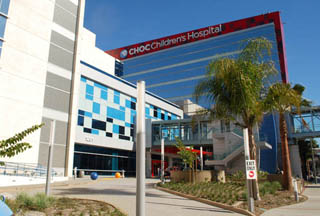
![]() Emergency Activation #118: At 11:45 PM on Thursday, July 18, 2013, all 120,000 customers of San Diego Gas and Electric in southern Orange County lost power, including residents of Laguna Hills, Laguna Beach, Mission Viejo and San Clemente. Four hospitals supported by HDSCS are in these communities, and all of them were immediately checked by HDSCS members to insure that the telephones in those facilities had not failed. No phone failures were reported, but San Clemente Hospital requested a HDSCS member to be an on-site standby for the duration of the outage. John Walker AC7GK responded, set up his portable station in the Hospital Command Post, and was in contact with HDSCS Net Control Ken Simpson W6KOS until power was restored around 3 AM.
Emergency Activation #118: At 11:45 PM on Thursday, July 18, 2013, all 120,000 customers of San Diego Gas and Electric in southern Orange County lost power, including residents of Laguna Hills, Laguna Beach, Mission Viejo and San Clemente. Four hospitals supported by HDSCS are in these communities, and all of them were immediately checked by HDSCS members to insure that the telephones in those facilities had not failed. No phone failures were reported, but San Clemente Hospital requested a HDSCS member to be an on-site standby for the duration of the outage. John Walker AC7GK responded, set up his portable station in the Hospital Command Post, and was in contact with HDSCS Net Control Ken Simpson W6KOS until power was restored around 3 AM.
![]() Emergency Activation #117: At 7:30 AM on January 9, 2013, HDSCS was activated by Children's Hospital of Orange County (CHOC) due to telephone problems. Dial tone was intermittent and incoming calls were not being received. Seven HDSCS communicators were immediately deployed in response. As the first two were arriving at CHOC, about 35 minutes after being called, service was being restored. In accordance with HDSCS procedures, they remained until full service was restored and stable for 30 minutes. This was the first time communicators had been in the newly relocated telephone center, which is in the basement of the newest patient tower. No Amateur Radio antenna has as yet been installed, but the incoming hams were well prepared. By setting up their own crossband repeater in the parking lot, they were able to establish communication to the external base station and between critical hospital locations. Communicating from the hospital were Glen Lowe KJ6YTN and Ken Simpson W6KOS. Other activated communicators were Cindy Orrico W6WGA, Joe Orrico WB6HRO and Fred Wagner KQ6Q. Net Controls and outside base stations providing support were April Moell WA6OPS and Joe Moell KØOV.
Emergency Activation #117: At 7:30 AM on January 9, 2013, HDSCS was activated by Children's Hospital of Orange County (CHOC) due to telephone problems. Dial tone was intermittent and incoming calls were not being received. Seven HDSCS communicators were immediately deployed in response. As the first two were arriving at CHOC, about 35 minutes after being called, service was being restored. In accordance with HDSCS procedures, they remained until full service was restored and stable for 30 minutes. This was the first time communicators had been in the newly relocated telephone center, which is in the basement of the newest patient tower. No Amateur Radio antenna has as yet been installed, but the incoming hams were well prepared. By setting up their own crossband repeater in the parking lot, they were able to establish communication to the external base station and between critical hospital locations. Communicating from the hospital were Glen Lowe KJ6YTN and Ken Simpson W6KOS. Other activated communicators were Cindy Orrico W6WGA, Joe Orrico WB6HRO and Fred Wagner KQ6Q. Net Controls and outside base stations providing support were April Moell WA6OPS and Joe Moell KØOV.
Selected Drills and Standby Operations
![]() Standby #125: HDSCS members were in place at 9 PM on Saturday, September 29, 2018 as UC-Irvine Medical Center in the city of Orange performed switchgear upgrades to its electrical system. Douglas Hospital, a trauma center on this campus, was on emergency power for the duration of the work. Using their own radio gear and the HDSCS portable UHF repeater, our operators were in constant contact with one another and with base stations operated first by April Moell WA6OPS and later by Paul Broden K6MHD and Joe Moell KØOV. All were ready in case the phone system failed and messages had to be relayed into and out of the hospital. The upgrades went smoothly and power was declared operational and stable at approximately 5:20 AM. Responders to the hospital (in shifts of varying lengths) were Bruce Chappell KE6TSM, Robert Doidge KI6KYW, Ed Dowler KK6KMM, Tom Gaccione WB2LRH, Jack Hafner KO6IC, Bob Houghton AD6QF, Craig Jones K6NNL, Justin Miller KI6AFZ, Dave Reinhard WW6I and Jim Whited AI6EZ.
Standby #125: HDSCS members were in place at 9 PM on Saturday, September 29, 2018 as UC-Irvine Medical Center in the city of Orange performed switchgear upgrades to its electrical system. Douglas Hospital, a trauma center on this campus, was on emergency power for the duration of the work. Using their own radio gear and the HDSCS portable UHF repeater, our operators were in constant contact with one another and with base stations operated first by April Moell WA6OPS and later by Paul Broden K6MHD and Joe Moell KØOV. All were ready in case the phone system failed and messages had to be relayed into and out of the hospital. The upgrades went smoothly and power was declared operational and stable at approximately 5:20 AM. Responders to the hospital (in shifts of varying lengths) were Bruce Chappell KE6TSM, Robert Doidge KI6KYW, Ed Dowler KK6KMM, Tom Gaccione WB2LRH, Jack Hafner KO6IC, Bob Houghton AD6QF, Craig Jones K6NNL, Justin Miller KI6AFZ, Dave Reinhard WW6I and Jim Whited AI6EZ.
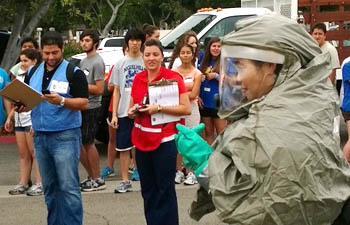
![]() Standby #124: Two HDSCS members were in place at 3:30 AM on Friday, September 21, 2018 as Foothill Regional Medical Center in Tustin performed upgrades to the electrical system. They were in constant contact with one another, with the hospital's Disaster Coordinator, and with the outside base station, which was ready in case the phone system failed and messages had to be relayed into and out of the hospital. Other HDSCS members stood by at home in case relief or additional operators were needed. The upgrades went smoothly and the system was declared operational and stable at approximately 5:30 AM. Responders to the hospital were Joe Orrico WB6HRO and Craig Jones K6NNL. Outside base station was Paul Broden K6MHD.
Standby #124: Two HDSCS members were in place at 3:30 AM on Friday, September 21, 2018 as Foothill Regional Medical Center in Tustin performed upgrades to the electrical system. They were in constant contact with one another, with the hospital's Disaster Coordinator, and with the outside base station, which was ready in case the phone system failed and messages had to be relayed into and out of the hospital. Other HDSCS members stood by at home in case relief or additional operators were needed. The upgrades went smoothly and the system was declared operational and stable at approximately 5:30 AM. Responders to the hospital were Joe Orrico WB6HRO and Craig Jones K6NNL. Outside base station was Paul Broden K6MHD.
![]() Drill #210: HDSCS was an important participant in the Orange County Multi-Agency Disaster Net (OCMAD) spring drill on May 15, 2018, which simulated an outbreak of wildfires that threatened numerous hospitals and forced partial or complete evacuations of some facilities. Hospitals used their pager activation plans to activate HDSCS members to their locations, where they set up rapidly in the Hospital Command Centers. Messages included coordination of simulated patient transfers as well as resource requests and reports to the county healthcare agency. Responding to hospitals and simulating other entities were Bruce Chappell KE6TSM, Craig Douglas KK6DBJ, Ed Dowler KK6KMM, Justin Ennen AI6CI, Tom Gaccione WB2LRH, Bill Greganti KG6EEK, Bob Houghton AD6QF, Craig Jones K6NNL, Rebecca Katzen KI6OEM, Greg Landers KE6DAN, Justin Miller KI6AFZ, Joe Moell KØOV, Dave Popko AF6TN, Rick Soikkeli N6NH, Claudia Whited W6YTD and
Jim Whited AI6EZ. Communicating from OC-EMS Department Operations Center was Jon Schaffer W6UFS. Net Control was April Moell WA6OPS (at left).
Drill #210: HDSCS was an important participant in the Orange County Multi-Agency Disaster Net (OCMAD) spring drill on May 15, 2018, which simulated an outbreak of wildfires that threatened numerous hospitals and forced partial or complete evacuations of some facilities. Hospitals used their pager activation plans to activate HDSCS members to their locations, where they set up rapidly in the Hospital Command Centers. Messages included coordination of simulated patient transfers as well as resource requests and reports to the county healthcare agency. Responding to hospitals and simulating other entities were Bruce Chappell KE6TSM, Craig Douglas KK6DBJ, Ed Dowler KK6KMM, Justin Ennen AI6CI, Tom Gaccione WB2LRH, Bill Greganti KG6EEK, Bob Houghton AD6QF, Craig Jones K6NNL, Rebecca Katzen KI6OEM, Greg Landers KE6DAN, Justin Miller KI6AFZ, Joe Moell KØOV, Dave Popko AF6TN, Rick Soikkeli N6NH, Claudia Whited W6YTD and
Jim Whited AI6EZ. Communicating from OC-EMS Department Operations Center was Jon Schaffer W6UFS. Net Control was April Moell WA6OPS (at left).
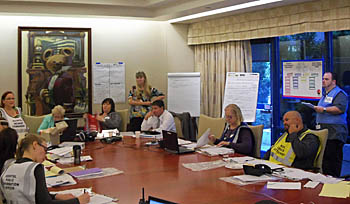
![]() Drill #209: The annual California Statewide Medical Health Exercise took place on Thursday, November 16, 2017. HDSCS members communicated from numerous hospitals plus a facility of Orange County Healthcare agency (OC-HCA). The drill scenario involved numerous acts of terrorism that caused a surge of patients at the hospitals, disrupted transportation in the county and overloaded communications systems. The HDSCS emphasis was a realistic response using our established Call-Up procedures. Our members received their assignments just a few hours before the event. Instead of going into the hospitals and setting up prior to the drill start, they pre-staged nearby and went inside after the hospitals activated HDSCS by telephone or pager. This taught our members what it is like to enter, get to Command Centers and get on the air quickly with their portable equipment under stressful conditions. In the individual Hospital Command Centers, our members were shoulder-to-shoulder with the Incident Commander, the Logistics Officer, and other staff members in Hospital Incident Command System positions. Drill participants at the hospitals were Paul Broden K6MHD, John Paul Dinglasan K6JPD, Matthew Edlin KK6RVY, Tom Gaccione WB2LRH, Dave Gorin KB6BXD, Reid Green KF6LOK, Bill Greganti KG6EEK, Tom Hall N6DGK, Bob Houghton AD6QF, Rebecca Katzen KI6OEM, Pete Martinez K2PTM, Dave Reinhard WW6I and Ken Simpson W6KOS. Net Control was April Moell WA6OPS. Joe Moell KØOV operated from the OC-HCA Operations Center. None of the HDSCS participants are hospital employees. They are ham operators of many occupations who have attended our specialized training sessions and took time off to support this valuable mission by being dedicated medical communicators.
Drill #209: The annual California Statewide Medical Health Exercise took place on Thursday, November 16, 2017. HDSCS members communicated from numerous hospitals plus a facility of Orange County Healthcare agency (OC-HCA). The drill scenario involved numerous acts of terrorism that caused a surge of patients at the hospitals, disrupted transportation in the county and overloaded communications systems. The HDSCS emphasis was a realistic response using our established Call-Up procedures. Our members received their assignments just a few hours before the event. Instead of going into the hospitals and setting up prior to the drill start, they pre-staged nearby and went inside after the hospitals activated HDSCS by telephone or pager. This taught our members what it is like to enter, get to Command Centers and get on the air quickly with their portable equipment under stressful conditions. In the individual Hospital Command Centers, our members were shoulder-to-shoulder with the Incident Commander, the Logistics Officer, and other staff members in Hospital Incident Command System positions. Drill participants at the hospitals were Paul Broden K6MHD, John Paul Dinglasan K6JPD, Matthew Edlin KK6RVY, Tom Gaccione WB2LRH, Dave Gorin KB6BXD, Reid Green KF6LOK, Bill Greganti KG6EEK, Tom Hall N6DGK, Bob Houghton AD6QF, Rebecca Katzen KI6OEM, Pete Martinez K2PTM, Dave Reinhard WW6I and Ken Simpson W6KOS. Net Control was April Moell WA6OPS. Joe Moell KØOV operated from the OC-HCA Operations Center. None of the HDSCS participants are hospital employees. They are ham operators of many occupations who have attended our specialized training sessions and took time off to support this valuable mission by being dedicated medical communicators.

![]() Drill #208: Although no Orange County hospitals activated their Command Centers for the annual Great California Shakeout on October 19, 2017, HDSCS members held their own on-air preparedness drill. Right after the simulated Richter 7.8 earthquake at 10:19 AM, members established a net and followed the procedures that would have been followed after an actual quake. Members checked in, stating their location and the hospital closest to them at that moment. In an actual quake situation, these members would either go to the closest hospital or would be reassigned to another hospital by Net Control to insure that the status of all supported hospitals would be determined as quickly as possible. From time to time, Net Control also asked questions regarding preparedness items that responders had with them. April Moell WA6OPS was Net Control. Net participants were Paul Broden K6MHD, Joe Dinglasan KM6JSD, Robert Doidge KI6KYW, Craig Douglas KK6DBJ, Dave Elder KA6TBF, Tom Gaccione WB2LRH, Bob Houghton AD6QF, Pete Martinez K2PTM, Joe Moell KØOV, Dale Petes KI6ANS, Ken Simpson W6KOS and Rick Soikkeli N6NH.
Drill #208: Although no Orange County hospitals activated their Command Centers for the annual Great California Shakeout on October 19, 2017, HDSCS members held their own on-air preparedness drill. Right after the simulated Richter 7.8 earthquake at 10:19 AM, members established a net and followed the procedures that would have been followed after an actual quake. Members checked in, stating their location and the hospital closest to them at that moment. In an actual quake situation, these members would either go to the closest hospital or would be reassigned to another hospital by Net Control to insure that the status of all supported hospitals would be determined as quickly as possible. From time to time, Net Control also asked questions regarding preparedness items that responders had with them. April Moell WA6OPS was Net Control. Net participants were Paul Broden K6MHD, Joe Dinglasan KM6JSD, Robert Doidge KI6KYW, Craig Douglas KK6DBJ, Dave Elder KA6TBF, Tom Gaccione WB2LRH, Bob Houghton AD6QF, Pete Martinez K2PTM, Joe Moell KØOV, Dale Petes KI6ANS, Ken Simpson W6KOS and Rick Soikkeli N6NH.
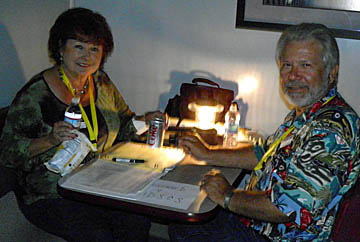
![]() Drill #207: The second Radio Amateur Civil Emergency Services (RACES) drill for Orange County in 2017 took place on October 7. In this "armchair" drill, our members do not physically go to the hospitals, but instead they simulate being at the hospitals in the various cities. The emphasis of this exercise is communications and message-handling with the city and county RACES groups. It is important for them to realize that we automatically go to hospitals in their cities during disasters. They need to understand the types of tactical messages that may need to pass between hospitals and local government. It's good practice for the various groups to move to each others' frequencies and to learn about their net procedures. This time, the scenario was extremely high temperatures and a major power failure. HDSCS simulated operations at twenty medical facilities plus the Orange County Health Care Agency. Sixteen city RACES groups, plus the county RACES and OC Red Cross exchanged messages and inquiries. HDSCS Net Control operator was Joe Moell KØOV. Bob Houghton AD6QF operated from the county's Emergency Operations Center. Other participating HDSCS members were Paul Broden K6MHD, Tom Gaccione WB2LRH, Reid Green KF6LOK, Tom Hall N6DGK, Rebecca Katzen KI6OEM, Greg Landers KE6DAN, Pete Martinez K2PTM, April Moell WA6OPS, Ken Simpson W6KOS and Ben Yu KK6RMX.
Drill #207: The second Radio Amateur Civil Emergency Services (RACES) drill for Orange County in 2017 took place on October 7. In this "armchair" drill, our members do not physically go to the hospitals, but instead they simulate being at the hospitals in the various cities. The emphasis of this exercise is communications and message-handling with the city and county RACES groups. It is important for them to realize that we automatically go to hospitals in their cities during disasters. They need to understand the types of tactical messages that may need to pass between hospitals and local government. It's good practice for the various groups to move to each others' frequencies and to learn about their net procedures. This time, the scenario was extremely high temperatures and a major power failure. HDSCS simulated operations at twenty medical facilities plus the Orange County Health Care Agency. Sixteen city RACES groups, plus the county RACES and OC Red Cross exchanged messages and inquiries. HDSCS Net Control operator was Joe Moell KØOV. Bob Houghton AD6QF operated from the county's Emergency Operations Center. Other participating HDSCS members were Paul Broden K6MHD, Tom Gaccione WB2LRH, Reid Green KF6LOK, Tom Hall N6DGK, Rebecca Katzen KI6OEM, Greg Landers KE6DAN, Pete Martinez K2PTM, April Moell WA6OPS, Ken Simpson W6KOS and Ben Yu KK6RMX.
![]() Drill #206: HDSCS was heavily involved in the Radio Amateur Civil Emergency Services (RACES) and MOU Partners drill for Orange County that took place on Saturday, May 6, 2017. The scenario was extreme levels of civil disorder, causing large numbers of injuries and disruption to services within the county. Our goal was to pass simulated messages between of our supported hospitals and their local municipalities as represented by city and county RACES organizations, in accordance with our Memorandum of Understanding. Also included were typical messages that would be relayed for the EMS Departmental Operations Center. Our net was busy almost non-stop! Other messages were passed via various city/county RACES repeaters and simplex frequencies. HDSCS Net Control operator was Joe Moell KØOV. April Moell WA6OPS simulated operations at the Orange County Emergency Medical Services Agency and Justin Ennen AI6CI operated from the Orange County EOC Radio Room at Loma Ridge.
Drill #206: HDSCS was heavily involved in the Radio Amateur Civil Emergency Services (RACES) and MOU Partners drill for Orange County that took place on Saturday, May 6, 2017. The scenario was extreme levels of civil disorder, causing large numbers of injuries and disruption to services within the county. Our goal was to pass simulated messages between of our supported hospitals and their local municipalities as represented by city and county RACES organizations, in accordance with our Memorandum of Understanding. Also included were typical messages that would be relayed for the EMS Departmental Operations Center. Our net was busy almost non-stop! Other messages were passed via various city/county RACES repeaters and simplex frequencies. HDSCS Net Control operator was Joe Moell KØOV. April Moell WA6OPS simulated operations at the Orange County Emergency Medical Services Agency and Justin Ennen AI6CI operated from the Orange County EOC Radio Room at Loma Ridge.
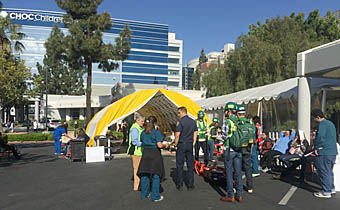
![]() Drill #205: The annual spring OCMAD Full Scale Exercise took place on April 12, 2017. The drill scenario was a major earthquake within the county that caused severe damage to some hospitals and necessitated some evacuations (photo at right). HDSCS members simulated a "core team" response, traveling to check on key facilities and providing reports to the county healthcare agency. Numerous requests for resources were also passed by Amateur Radio. Responding to twenty hospitals were Paul Broden K6MHD, Louie DeArman K6SM, Craig Douglas KK6DBJ, Matthew Edlin KK6RVY, Ross Farley KK6DTO, Tom Gaccione WB2LRH, David Gorin KB6BXD, Bob Houghton AD6QF, Scott Kamangar W6SSK, Rebecca Katzen KI6OEM, Greg Landers KE6DAN, Natalie Lopez KM6CNB, Glen Lowe KJ6YTN, Pete Martinez K2PTM, Jim McLaughlin AB6UF, Justin Miller KI6AFZ, Joe Orrico WB6HRO, Dave Reinhard KJ6REP, Carlos Santos KK6KUF, Ken Simpson W6KOS and Jim Whited AI6EZ. Communicating from OC-EMS Department Operations Center was Joe Moell KØOV. Net Control was April Moell WA6OPS (at left).
Drill #205: The annual spring OCMAD Full Scale Exercise took place on April 12, 2017. The drill scenario was a major earthquake within the county that caused severe damage to some hospitals and necessitated some evacuations (photo at right). HDSCS members simulated a "core team" response, traveling to check on key facilities and providing reports to the county healthcare agency. Numerous requests for resources were also passed by Amateur Radio. Responding to twenty hospitals were Paul Broden K6MHD, Louie DeArman K6SM, Craig Douglas KK6DBJ, Matthew Edlin KK6RVY, Ross Farley KK6DTO, Tom Gaccione WB2LRH, David Gorin KB6BXD, Bob Houghton AD6QF, Scott Kamangar W6SSK, Rebecca Katzen KI6OEM, Greg Landers KE6DAN, Natalie Lopez KM6CNB, Glen Lowe KJ6YTN, Pete Martinez K2PTM, Jim McLaughlin AB6UF, Justin Miller KI6AFZ, Joe Orrico WB6HRO, Dave Reinhard KJ6REP, Carlos Santos KK6KUF, Ken Simpson W6KOS and Jim Whited AI6EZ. Communicating from OC-EMS Department Operations Center was Joe Moell KØOV. Net Control was April Moell WA6OPS (at left).
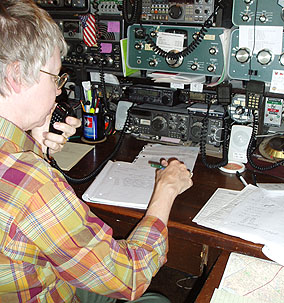
![]() Standbys #121 and #123: Early on Sunday morning, January 22, 2017, HDSCS communicators were on site at Placentia-Linda Hospital for planned power system work. No down time of the telephone system was expected, but as with all standbys, we were there for rapid response if something were to go wrong and affect the telephones. As it turned out, a problem with the hospital's generator prevented the planned power work from being done, and the standby operation was terminated after about four hours, to be rescheduled later. Operating in the hospital were Tom Gaccione WB2LRH, Bob Houghton AD6QF and Dale Petes KI6ANS. Outside base station operators were Paul Broden K6MHD, April Moell WA6OPS and Joe Moell KØOV. The work was rescheduled for the late evening of Friday, February 24 and once again a team of HDSCS members was there for support. Although there were delays, the work was successfully completed and the team secured operations at 6:15 AM. In the hospital were Paul Broden K6MHD, Bob Houghton AD6QF, Dale Petes KI6ANS and Jim Whited AI6EZ. Outside base station operators were April Moell WA6OPS and Joe Moell KØOV.
Standbys #121 and #123: Early on Sunday morning, January 22, 2017, HDSCS communicators were on site at Placentia-Linda Hospital for planned power system work. No down time of the telephone system was expected, but as with all standbys, we were there for rapid response if something were to go wrong and affect the telephones. As it turned out, a problem with the hospital's generator prevented the planned power work from being done, and the standby operation was terminated after about four hours, to be rescheduled later. Operating in the hospital were Tom Gaccione WB2LRH, Bob Houghton AD6QF and Dale Petes KI6ANS. Outside base station operators were Paul Broden K6MHD, April Moell WA6OPS and Joe Moell KØOV. The work was rescheduled for the late evening of Friday, February 24 and once again a team of HDSCS members was there for support. Although there were delays, the work was successfully completed and the team secured operations at 6:15 AM. In the hospital were Paul Broden K6MHD, Bob Houghton AD6QF, Dale Petes KI6ANS and Jim Whited AI6EZ. Outside base station operators were April Moell WA6OPS and Joe Moell KØOV.
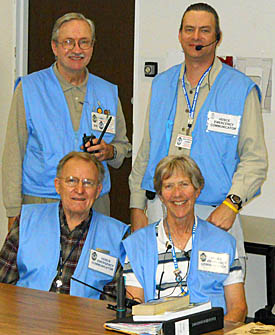
![]() Standby #122: Repair work necessitated a complete shutdown of telephones at Mission Regional Hospital in Mission Viejo, so at 11 PM on February 21, 2017, five HDSCS members were in place to provide backup communications for critical units within the facility: Emergency Department, Intensive Care, Cardiac Care, Laboratory and Pharmacy. The work was complete by 2:30 AM, then HDSCS stood by for an additional half hour to insure that the system was stable. In the hospital were Tom Hall N6DGK, Bob Houghton AD6QF, Scott Kamangar W6SSK, Joe Orrico WB6HRO and Allen Renning WB6CKG. Outside base station operators were April Moell WA6OPS and Joe Moell KØOV.
Standby #122: Repair work necessitated a complete shutdown of telephones at Mission Regional Hospital in Mission Viejo, so at 11 PM on February 21, 2017, five HDSCS members were in place to provide backup communications for critical units within the facility: Emergency Department, Intensive Care, Cardiac Care, Laboratory and Pharmacy. The work was complete by 2:30 AM, then HDSCS stood by for an additional half hour to insure that the system was stable. In the hospital were Tom Hall N6DGK, Bob Houghton AD6QF, Scott Kamangar W6SSK, Joe Orrico WB6HRO and Allen Renning WB6CKG. Outside base station operators were April Moell WA6OPS and Joe Moell KØOV.
![]() Drill #204: A mass casualty incident was the scenario for the 2016 California Statewide Medical Health Exercise. On November 17, according to the exercise scenario, a train traveling through the county with 100 cars of mixed freight collided with a large truck at a grade crossing, resulting in a 23-car derailment with tank cars impacting two buses full of school children. A large surge of pediatric patients at the hospitals caused overloading of communications systems. HDSCS members communicated from numerous hospitals plus a facility of Orange County Healthcare agency (OC-HCA). Our emphasis was a realistic response using our established Call-Up procedures. Our members received their assignments just a few hours before the event. Instead of going into the hospitals and setting up prior to the drill start, they pre-staged nearby and went inside after the hospitals activated HDSCS by telephone or pager. This taught our members what it is like to enter, get to Command Centers and get on the air quickly with their portable equipment under stressful conditions. In the individual Hospital Command Centers, our members were shoulder-to-shoulder with the Incident Commander, the Logistics Officer, and other staff members in Hospital Incident Command System positions. About halfway through the exercise, a power outage occurred in the neighborhood of Foothill Regional Medical Center. The hospital went to generator power and HDSCS members readied to bring in additional communicators if a telephone outage occurred. Drill participants at the hospitals were Matthew Edlin KK6RVY, Ross Farley KK6DTO, Tom Gaccione WB2LRH, Dave Gorin KB6BXD, Tom Hall N6DGK, Bob Houghton AD6QF, Rebecca Katzen KI6OEM, Ted Kramer NB6N, Pete Martinez K2PTM, Justin Miller KI6AFZ, Joe Moell KØOV, Dale Petes KI6ANS, Dave Reinhard KJ6REP, Carlos Santos KK6KUF, Ken Simpson W6KOS, Claudia Whited W6YTD, Jim Whited AI6EZ and Dave West KI6EPI. Net Control was April Moell WA6OPS and. Jon Schaffer W6UFS operated from the OC-HCA Operations Center.
Drill #204: A mass casualty incident was the scenario for the 2016 California Statewide Medical Health Exercise. On November 17, according to the exercise scenario, a train traveling through the county with 100 cars of mixed freight collided with a large truck at a grade crossing, resulting in a 23-car derailment with tank cars impacting two buses full of school children. A large surge of pediatric patients at the hospitals caused overloading of communications systems. HDSCS members communicated from numerous hospitals plus a facility of Orange County Healthcare agency (OC-HCA). Our emphasis was a realistic response using our established Call-Up procedures. Our members received their assignments just a few hours before the event. Instead of going into the hospitals and setting up prior to the drill start, they pre-staged nearby and went inside after the hospitals activated HDSCS by telephone or pager. This taught our members what it is like to enter, get to Command Centers and get on the air quickly with their portable equipment under stressful conditions. In the individual Hospital Command Centers, our members were shoulder-to-shoulder with the Incident Commander, the Logistics Officer, and other staff members in Hospital Incident Command System positions. About halfway through the exercise, a power outage occurred in the neighborhood of Foothill Regional Medical Center. The hospital went to generator power and HDSCS members readied to bring in additional communicators if a telephone outage occurred. Drill participants at the hospitals were Matthew Edlin KK6RVY, Ross Farley KK6DTO, Tom Gaccione WB2LRH, Dave Gorin KB6BXD, Tom Hall N6DGK, Bob Houghton AD6QF, Rebecca Katzen KI6OEM, Ted Kramer NB6N, Pete Martinez K2PTM, Justin Miller KI6AFZ, Joe Moell KØOV, Dale Petes KI6ANS, Dave Reinhard KJ6REP, Carlos Santos KK6KUF, Ken Simpson W6KOS, Claudia Whited W6YTD, Jim Whited AI6EZ and Dave West KI6EPI. Net Control was April Moell WA6OPS and. Jon Schaffer W6UFS operated from the OC-HCA Operations Center.
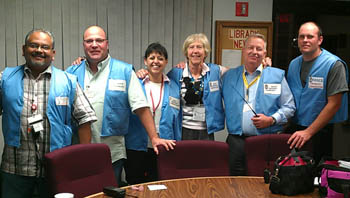
![]() Standby #120: It was another all-nighter (nearly) for some HDSCS members as UCI Medical Center performed a telephone system conversion starting at 9 PM on August 12, 2016. Our communicators were in five critical areas of the facility, keeping in touch with one another through the HDSCS portable UHF repeater that was set up in the Hospital Command Center. An outside base station was always ready to accept outgoing messages. Operating within the facility for shifts of various lengths were Dave Conklin KI6LYZ, Tom Gaccione WB2LRH, David Gorin KB6BXD, Bill Greganti KG6EEK, Rebecca Katzen KI6OEM, Greg Landers KE6DAN, Justin Miller KI6AFZ, Dave Reinhard KJ6REP and Carlos Santos KK6UF. Base station operators were Paul Broden K6MHD, April Moell WA6OPS and Joe Moell KØOV.
Standby #120: It was another all-nighter (nearly) for some HDSCS members as UCI Medical Center performed a telephone system conversion starting at 9 PM on August 12, 2016. Our communicators were in five critical areas of the facility, keeping in touch with one another through the HDSCS portable UHF repeater that was set up in the Hospital Command Center. An outside base station was always ready to accept outgoing messages. Operating within the facility for shifts of various lengths were Dave Conklin KI6LYZ, Tom Gaccione WB2LRH, David Gorin KB6BXD, Bill Greganti KG6EEK, Rebecca Katzen KI6OEM, Greg Landers KE6DAN, Justin Miller KI6AFZ, Dave Reinhard KJ6REP and Carlos Santos KK6UF. Base station operators were Paul Broden K6MHD, April Moell WA6OPS and Joe Moell KØOV.
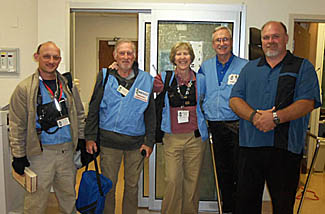
![]() Standby #119: When Huntington Beach Hospital performed work on its telephone trunk lines in the wee hours of June 24, 2016, HDSCS members were present to provide immediate support in the event of telephone problems in the 131-bed facility. Tom Gaccione WB2LRH was in the Emergency Department, Justin Miller KI6AFZ was in the Hospital Command Center and Rebecca Katzen KI6OEM was "shadow" to the House Supervisor. Serving as outside base station operators were April Moell WA6OPS and Joe Moell KØOV. Other members were standing by in case additional time was needed. Fortunately, the work went smoothly and was completed by 4:45 AM.
Standby #119: When Huntington Beach Hospital performed work on its telephone trunk lines in the wee hours of June 24, 2016, HDSCS members were present to provide immediate support in the event of telephone problems in the 131-bed facility. Tom Gaccione WB2LRH was in the Emergency Department, Justin Miller KI6AFZ was in the Hospital Command Center and Rebecca Katzen KI6OEM was "shadow" to the House Supervisor. Serving as outside base station operators were April Moell WA6OPS and Joe Moell KØOV. Other members were standing by in case additional time was needed. Fortunately, the work went smoothly and was completed by 4:45 AM.
![]() Standby #118: At 8 PM on May 20, 2016, all the telephones of Huntington Beach Hospital were taken down for several hours while a major upgrade to the system was performed. The hospital's Disaster Coordinator had requested support from HDSCS in advance, so operators were in place in the Command Center and critical units with internal UHF communications from beginning to end. We "shadowed" the House Supervisor and communicated from Emergency Department, Intensive Care and the Laboratory. April Moell WA6OPS and Jon Schaffer W6UFS were outside base stations, serving as a lifeline for external communications. HDSCS members inside the hospital were Matthew Edlin KK6RVY, Tom Gaccione WB2LRH, Tom Hall N6DGK, Bob Houghton AD6QF, Rebecca Katzen KI6OEM and Natalie Lopez KM6CNB,
Standby #118: At 8 PM on May 20, 2016, all the telephones of Huntington Beach Hospital were taken down for several hours while a major upgrade to the system was performed. The hospital's Disaster Coordinator had requested support from HDSCS in advance, so operators were in place in the Command Center and critical units with internal UHF communications from beginning to end. We "shadowed" the House Supervisor and communicated from Emergency Department, Intensive Care and the Laboratory. April Moell WA6OPS and Jon Schaffer W6UFS were outside base stations, serving as a lifeline for external communications. HDSCS members inside the hospital were Matthew Edlin KK6RVY, Tom Gaccione WB2LRH, Tom Hall N6DGK, Bob Houghton AD6QF, Rebecca Katzen KI6OEM and Natalie Lopez KM6CNB,
Meetings and Other Activities
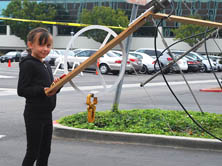
![]() At a five-hour mini-workshop on Saturday, September 8, 2018, a group of the newest HDSCS members got "up to speed" in their knowledge and preparation for supporting hospitals. Basics of hospital support, the Hospital Incident Command System, activation procedures, message protocol, "go kits" and repeater use were well covered. This session was especially for members who had not been able to attend the annual all-day training workshop in March. April Moell WA6OPS was the primary presenter, assisted by Joe Moell KØOV and Tom Gaccione WB2LRH.
At a five-hour mini-workshop on Saturday, September 8, 2018, a group of the newest HDSCS members got "up to speed" in their knowledge and preparation for supporting hospitals. Basics of hospital support, the Hospital Incident Command System, activation procedures, message protocol, "go kits" and repeater use were well covered. This session was especially for members who had not been able to attend the annual all-day training workshop in March. April Moell WA6OPS was the primary presenter, assisted by Joe Moell KØOV and Tom Gaccione WB2LRH.
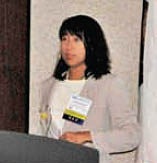
![]() Field Day is an annual communications preparedness exercise of the American Radio Relay League in which HDSCS has participated for many years. 2018 was the seventeenth year that our Field Day took place at Huntington Beach Hospital (HBH), one of our supported facilities. The hospital's decontamination and surge capacity tents were set up to house our stations. HBH employees and staff as well as county emergency management officials were encouraged to visit our operation. In mid-afternoon was a ham radio licensing and upgrade session. Besides the usual voice operations, members operated CW mode (Morse Code) and there were many contacts through eight orbiting Amateur Radio satellites. Many thanks to Tom Gaccione WB2LRH for organizing, to Rick Soikkeli N6NH for setting up the computer logging network, to Joe Moell KØOV for the satellite station, to Tom Hall N6DGK for the solar-powered station, to Bob Houghton AD6QF for heading up the GOTA station, to Woody Woodward W6PA and Dave Reinhard WW6I for the use of their callsigns and to Ken Simpson W6KOS for preparing the results package to submit to ARRL. Click here for a page of photos from HDSCS Field Day.
Field Day is an annual communications preparedness exercise of the American Radio Relay League in which HDSCS has participated for many years. 2018 was the seventeenth year that our Field Day took place at Huntington Beach Hospital (HBH), one of our supported facilities. The hospital's decontamination and surge capacity tents were set up to house our stations. HBH employees and staff as well as county emergency management officials were encouraged to visit our operation. In mid-afternoon was a ham radio licensing and upgrade session. Besides the usual voice operations, members operated CW mode (Morse Code) and there were many contacts through eight orbiting Amateur Radio satellites. Many thanks to Tom Gaccione WB2LRH for organizing, to Rick Soikkeli N6NH for setting up the computer logging network, to Joe Moell KØOV for the satellite station, to Tom Hall N6DGK for the solar-powered station, to Bob Houghton AD6QF for heading up the GOTA station, to Woody Woodward W6PA and Dave Reinhard WW6I for the use of their callsigns and to Ken Simpson W6KOS for preparing the results package to submit to ARRL. Click here for a page of photos from HDSCS Field Day.
![]() Members attending the HDSCS meeting of May 10, 2018 were treated to a comprehensive presentation on TRAIN by Michelle Cheung, MD, MPH (at left). She is Deputy Director of Epidemiology for the Orange County Health Care Agency. Triage by Resource Allocation for IN-patient (TRAIN) is a tool for pediatric hospital disaster pre-planning. Also at the meeting, April Moell WA6OPS gave a presentation on messaging and nets in preparation for the upcoming spring medical exercise.
Members attending the HDSCS meeting of May 10, 2018 were treated to a comprehensive presentation on TRAIN by Michelle Cheung, MD, MPH (at left). She is Deputy Director of Epidemiology for the Orange County Health Care Agency. Triage by Resource Allocation for IN-patient (TRAIN) is a tool for pediatric hospital disaster pre-planning. Also at the meeting, April Moell WA6OPS gave a presentation on messaging and nets in preparation for the upcoming spring medical exercise.
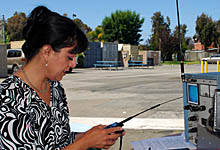
![]() HDSCS holds frequent "radio coaching" sessions to help new members become proficient at operating their own portable equipment. The most recent session was April 26, 2018 at the headquarters of Care Ambulance. Tom Gaccione WB2LRH and Joe Moell KØOV explained the basics of VHF/UHF repeaters, subaudible tones, and hand-held radio programming. The attendees were assigned to individual radio coaches who helped them master the technique of quickly finding frequencies and programming memories. Coaches this time were Tom Gaccione WB2LRH, Bob Houghton AD6QF, Joe Moell KØOV and Ken Simpson W6KOS. This is important because during drills and activations, HDSCS members often have to quickly get resources from the Red Cross, local RACES groups, and so forth by going to their net repeaters and simplex frequencies.
HDSCS holds frequent "radio coaching" sessions to help new members become proficient at operating their own portable equipment. The most recent session was April 26, 2018 at the headquarters of Care Ambulance. Tom Gaccione WB2LRH and Joe Moell KØOV explained the basics of VHF/UHF repeaters, subaudible tones, and hand-held radio programming. The attendees were assigned to individual radio coaches who helped them master the technique of quickly finding frequencies and programming memories. Coaches this time were Tom Gaccione WB2LRH, Bob Houghton AD6QF, Joe Moell KØOV and Ken Simpson W6KOS. This is important because during drills and activations, HDSCS members often have to quickly get resources from the Red Cross, local RACES groups, and so forth by going to their net repeaters and simplex frequencies.
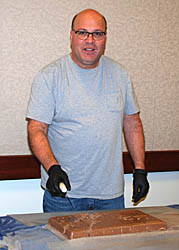
![]() The annual HDSCS Orientation and Review Workshop took place at the Schilling Training Center of Care Ambulance Service on Saturday, March 24, 2018. It was a full day with reviews of basic concepts, procedures, and preparedness, along with updates on handling medical messages and doing realistic drills. Members brought in their "go kits" and portable stations for show and tell. In addition to the usual learning modules presented by April Moell WA6OPS, Joe Moell KØOV and Tom Gaccione WB2LRH, there was a special presentation on dialysis by Danilo Concepcion, CBNT, Operations Manager of Renal Services at St. Joseph Hospital. As always, a highlight was the noontime "disaster potluck." Click for photos and more informaton about our annual workshop.
The annual HDSCS Orientation and Review Workshop took place at the Schilling Training Center of Care Ambulance Service on Saturday, March 24, 2018. It was a full day with reviews of basic concepts, procedures, and preparedness, along with updates on handling medical messages and doing realistic drills. Members brought in their "go kits" and portable stations for show and tell. In addition to the usual learning modules presented by April Moell WA6OPS, Joe Moell KØOV and Tom Gaccione WB2LRH, there was a special presentation on dialysis by Danilo Concepcion, CBNT, Operations Manager of Renal Services at St. Joseph Hospital. As always, a highlight was the noontime "disaster potluck." Click for photos and more informaton about our annual workshop.
![]() HDSCS held its traditional annual Year-End/Year-Beginning meeting, complete with the "Final Exam" on January 31, 2018 at Care Ambulance headquarters in Orange. As always, attendees were divided into teams to answer the questions, which included hospital terminology and practical in-hospital communications techniques. The team with the best score received prizes and everyone got a share of the well-chiseled UBCB (Unbelievably Big Chocolate Bar, at left). Certificates, prizes and HDSCS coins were presented to the most active members of the previous year. Pictured at right are three first-time Disaster Dozen members, who received HDSCS coin. They are Bob Houghton AD6QF, Greg Landers KE6DAN, Paul Broden K6MHD, Tom Gaccione WB2LRH, Rebecca Katzen KI6OEM, Joe Moell KØOV and Ken Simpson W6KOS. Winner of the Outstanding New Member award for exceptional participation by a person who joined during 2017 was Benjamin Yu KK6RMX.
HDSCS held its traditional annual Year-End/Year-Beginning meeting, complete with the "Final Exam" on January 31, 2018 at Care Ambulance headquarters in Orange. As always, attendees were divided into teams to answer the questions, which included hospital terminology and practical in-hospital communications techniques. The team with the best score received prizes and everyone got a share of the well-chiseled UBCB (Unbelievably Big Chocolate Bar, at left). Certificates, prizes and HDSCS coins were presented to the most active members of the previous year. Pictured at right are three first-time Disaster Dozen members, who received HDSCS coin. They are Bob Houghton AD6QF, Greg Landers KE6DAN, Paul Broden K6MHD, Tom Gaccione WB2LRH, Rebecca Katzen KI6OEM, Joe Moell KØOV and Ken Simpson W6KOS. Winner of the Outstanding New Member award for exceptional participation by a person who joined during 2017 was Benjamin Yu KK6RMX.
![]() When HDSCS members met at Care Ambulance headquarters on March 29, 2017, the topic was planning and procedures for evacuation of hospitals. The presenters included Greg Landers KE6DAN, a former hospital administrator and Mike Steinkraus N6PTN, the Medical Disaster Management Coordinator of Orange County Emergency Medical Services Agency. Care Ambulance showed one of its newest vehicles and there were also presentations by Sean Cox, Care's Disaster Coordinator, and Lisa Carrillo, Care's Community Educator.
When HDSCS members met at Care Ambulance headquarters on March 29, 2017, the topic was planning and procedures for evacuation of hospitals. The presenters included Greg Landers KE6DAN, a former hospital administrator and Mike Steinkraus N6PTN, the Medical Disaster Management Coordinator of Orange County Emergency Medical Services Agency. Care Ambulance showed one of its newest vehicles and there were also presentations by Sean Cox, Care's Disaster Coordinator, and Lisa Carrillo, Care's Community Educator.
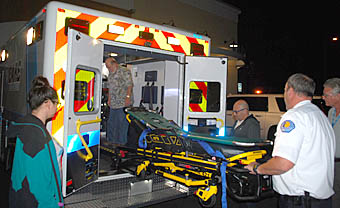
![]() Regulations affecting hospital accreditation, disaster planning and Command Center operations was the subject of the HDSCS membership meeting of November 14, 2016 at Kaiser Permanente Hospital in Anaheim. Our speaker was Gregory Landers, C.P.M. KE6DAN, the Executive Director of Support Services at Long Beach Memorial Medical Center and Miller Children's Hospital.
Regulations affecting hospital accreditation, disaster planning and Command Center operations was the subject of the HDSCS membership meeting of November 14, 2016 at Kaiser Permanente Hospital in Anaheim. Our speaker was Gregory Landers, C.P.M. KE6DAN, the Executive Director of Support Services at Long Beach Memorial Medical Center and Miller Children's Hospital.
![]() HDSCS held a well-attended membership meeting in the Command Center conference room of UCI Medical Center in Orange on September 29, 2016. The hospital provided a buffet supper, then Dr. Sam Stratton W5AGX gave a presentation on the trauma centers in Orange and surrounding counties. Eleven members received service pins for providing communications in hospitals when telephones were down in recent months.
HDSCS held a well-attended membership meeting in the Command Center conference room of UCI Medical Center in Orange on September 29, 2016. The hospital provided a buffet supper, then Dr. Sam Stratton W5AGX gave a presentation on the trauma centers in Orange and surrounding counties. Eleven members received service pins for providing communications in hospitals when telephones were down in recent months.
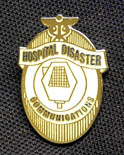
![]() Response to an active shooter situation was the topic of the HDSCS membership meeting on May 16, 2016. Our speaker was George Bandy, the Director of Security at Orange County Global Medical Center.
Response to an active shooter situation was the topic of the HDSCS membership meeting on May 16, 2016. Our speaker was George Bandy, the Director of Security at Orange County Global Medical Center.
![]() Many HDSCS members have been awarded special pins to recognize their prior service to medical facilities. These 1.2-inch HDSCS logo pins were given to members who have provided Amateur Radio communications within our supported hospitals when telephones were inoperative or overloaded in a planned or unplanned event. Pins were presented to new members after their first service within a hospital under the same circumstances. More than 85 HDSCS members have qualified for pins. According to HDSCS leader April Moell WA6OPS, "This is a great way to recognize our members for doing what they train and prepare to do, namely to help hospital patients by providing essential communications for their caregivers. Thanks to Dave West KI6EPI for donating these fine pins."
Many HDSCS members have been awarded special pins to recognize their prior service to medical facilities. These 1.2-inch HDSCS logo pins were given to members who have provided Amateur Radio communications within our supported hospitals when telephones were inoperative or overloaded in a planned or unplanned event. Pins were presented to new members after their first service within a hospital under the same circumstances. More than 85 HDSCS members have qualified for pins. According to HDSCS leader April Moell WA6OPS, "This is a great way to recognize our members for doing what they train and prepare to do, namely to help hospital patients by providing essential communications for their caregivers. Thanks to Dave West KI6EPI for donating these fine pins."
![]() HDSCS recommends that all supported hospitals install VHF/UHF rooftop antennas with low-loss coaxial cable going to the room designated as the Hospital Command Center. Some hospitals have installed additional antennas to serve important units such as the Emergency Department. Funding for some of these antennas has been by grants obtained by the Orange County Heathcare Agency. In most cases, antenna masts are installed and coax cables are run by hospital engineering staff, then volunteer members of the HDSCS Antenna Team place the antennas on the mast, put connectors on the coax, and test the completed antenna assembly.
HDSCS recommends that all supported hospitals install VHF/UHF rooftop antennas with low-loss coaxial cable going to the room designated as the Hospital Command Center. Some hospitals have installed additional antennas to serve important units such as the Emergency Department. Funding for some of these antennas has been by grants obtained by the Orange County Heathcare Agency. In most cases, antenna masts are installed and coax cables are run by hospital engineering staff, then volunteer members of the HDSCS Antenna Team place the antennas on the mast, put connectors on the coax, and test the completed antenna assembly.
Outreach

![]() Regular contact with our served hospitals and other agencies insured that HDSCS would be remembered and called out quickly in all Orange County hospital emergency situations. Each year, HDSCS leaders participated in numerous meetings with Disaster/Safety Committee members from hospitals in the Red, Blue/Green, and Yellow Nets for education, coordination and drill planning. HDSCS was also represented at regular meetings of the Orange County Emergency Medical Services' Disaster Advisory Group (12 per year), the OC-EMS Healthcare Preparedness Advisory Committee (4 per year) and the ReddiNet* Technical Advisory Group (2 per year). In addition to those meetings, HDSCS went on the road, explaining our mission to medical care personnel, ham radio operators, and the public in southern California and elsewhere. Special presentations, conferences and exhibitions in recent months included:
Regular contact with our served hospitals and other agencies insured that HDSCS would be remembered and called out quickly in all Orange County hospital emergency situations. Each year, HDSCS leaders participated in numerous meetings with Disaster/Safety Committee members from hospitals in the Red, Blue/Green, and Yellow Nets for education, coordination and drill planning. HDSCS was also represented at regular meetings of the Orange County Emergency Medical Services' Disaster Advisory Group (12 per year), the OC-EMS Healthcare Preparedness Advisory Committee (4 per year) and the ReddiNet* Technical Advisory Group (2 per year). In addition to those meetings, HDSCS went on the road, explaining our mission to medical care personnel, ham radio operators, and the public in southern California and elsewhere. Special presentations, conferences and exhibitions in recent months included:
